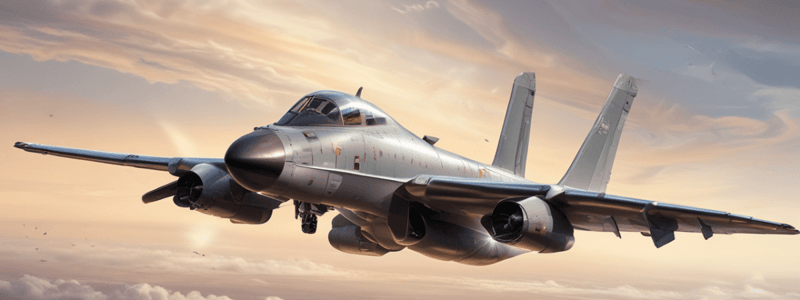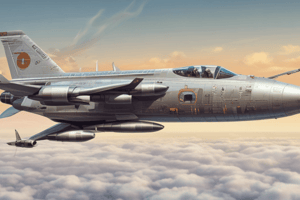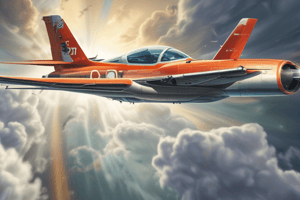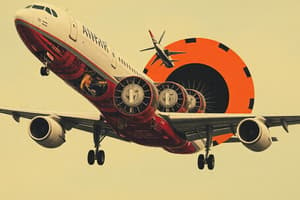Podcast
Questions and Answers
What is the primary role of thrust in an aircraft?
What is the primary role of thrust in an aircraft?
- To overcome drag and enable acceleration (correct)
- To create an aerodynamic force for stable flight
- To counteract the force of lift
- To generate an opposing force to weight
What is the result when thrust exceeds drag in an aircraft?
What is the result when thrust exceeds drag in an aircraft?
- The aircraft maintains a constant speed
- The aircraft experiences turbulence
- The aircraft accelerates (correct)
- The aircraft decelerates
According to Newton's third law of motion, what is the principle behind jet engine thrust?
According to Newton's third law of motion, what is the principle behind jet engine thrust?
- For every action, there is a simultaneous reaction
- For every action, there is a greater and opposite reaction
- For every action, there is a lesser and opposite reaction
- For every action, there is an equal and opposite reaction (correct)
What is the primary function of a propeller in an aircraft?
What is the primary function of a propeller in an aircraft?
What is the primary factor that determines the efficiency of jet engines versus propeller systems?
What is the primary factor that determines the efficiency of jet engines versus propeller systems?
What is the primary role of lift in an aircraft?
What is the primary role of lift in an aircraft?
What is the significance of the thrust-to-weight ratio in an aircraft?
What is the significance of the thrust-to-weight ratio in an aircraft?
What is the primary determinant of an aircraft's acceleration and maneuverability?
What is the primary determinant of an aircraft's acceleration and maneuverability?
In what phase of flight is maximum thrust typically used?
In what phase of flight is maximum thrust typically used?
What is the primary goal of managing thrust in flight operations?
What is the primary goal of managing thrust in flight operations?
What is the primary reason air moves faster over the top surface of an airfoil?
What is the primary reason air moves faster over the top surface of an airfoil?
What happens to lift when the angle of attack is increased beyond a certain limit?
What happens to lift when the angle of attack is increased beyond a certain limit?
What is the relationship between an aircraft's speed and the lift it generates?
What is the relationship between an aircraft's speed and the lift it generates?
What is the primary force produced by an aircraft's powerplant?
What is the primary force produced by an aircraft's powerplant?
Why do larger wing surface areas enable an aircraft to support more weight?
Why do larger wing surface areas enable an aircraft to support more weight?
What is the primary force that counteracts the thrust of an aircraft in flight?
What is the primary force that counteracts the thrust of an aircraft in flight?
What shape is the wing of an aircraft designed to be?
What shape is the wing of an aircraft designed to be?
What is the result of exceeding the critical angle of attack?
What is the result of exceeding the critical angle of attack?
What is the principle that explains the relationship between pressure and velocity in the generation of lift?
What is the principle that explains the relationship between pressure and velocity in the generation of lift?
When an aircraft needs to climb, what does the pilot do to increase lift?
When an aircraft needs to climb, what does the pilot do to increase lift?
An aircraft's wings are designed to be completely symmetrical in shape.
An aircraft's wings are designed to be completely symmetrical in shape.
Thrust is the upward force that is essential for an aircraft to ascend and remain aloft.
Thrust is the upward force that is essential for an aircraft to ascend and remain aloft.
The critical angle of attack is the point at which an aircraft generates maximum lift.
The critical angle of attack is the point at which an aircraft generates maximum lift.
The shape of the wing alone determines the amount of lift generated.
The shape of the wing alone determines the amount of lift generated.
Bernoulli's Principle states that for every action, there is an equal and opposite reaction.
Bernoulli's Principle states that for every action, there is an equal and opposite reaction.
The pilot must increase lift to gain speed when the aircraft needs to climb.
The pilot must increase lift to gain speed when the aircraft needs to climb.
Drag is the downward force that counteracts lift.
Drag is the downward force that counteracts lift.
The angle of attack has no effect on the amount of lift generated by the wing.
The angle of attack has no effect on the amount of lift generated by the wing.
An increase in thrust always results in an increase in lift.
An increase in thrust always results in an increase in lift.
The relationship between thrust and lift is that they are mutually exclusive forces.
The relationship between thrust and lift is that they are mutually exclusive forces.
What is the underlying principle that explains why an increase in thrust leads to an increase in lift, when an aircraft needs to climb?
What is the underlying principle that explains why an increase in thrust leads to an increase in lift, when an aircraft needs to climb?
What happens to the airflow around the wing when it exceeds the critical angle of attack?
What happens to the airflow around the wing when it exceeds the critical angle of attack?
How do the shape and angle of attack of the wing work together to generate lift?
How do the shape and angle of attack of the wing work together to generate lift?
What is the relationship between an aircraft's speed and the drag it encounters?
What is the relationship between an aircraft's speed and the drag it encounters?
What is the primary goal of managing the balance between thrust and lift in straight-and-level flight?
What is the primary goal of managing the balance between thrust and lift in straight-and-level flight?
According to Newton's Third Law of Motion, what is the reaction to the forward motion of the aircraft?
According to Newton's Third Law of Motion, what is the reaction to the forward motion of the aircraft?
What is the primary force that counteracts the weight of the aircraft in flight?
What is the primary force that counteracts the weight of the aircraft in flight?
How does the pilot control the aircraft's descent?
How does the pilot control the aircraft's descent?
What is the result of a delicate balance between thrust, lift, drag, and weight in an aircraft?
What is the result of a delicate balance between thrust, lift, drag, and weight in an aircraft?
What is the primary factor that determines the amount of lift generated by the wing?
What is the primary factor that determines the amount of lift generated by the wing?
Flashcards are hidden until you start studying
Study Notes
Thrust in Flight
- Thrust is a mechanical force that moves an aircraft through the air, generated in the opposite direction of drag.
- Without thrust, an aircraft cannot overcome drag to accelerate and takeoff.
- Thrust is the propelling force that drives an aircraft ahead, overcoming resistance and, in combination with lift, enables flight.
Thrust Generation
- Thrust is most commonly produced by jet engines or propellers.
- Jet engines expel gases at high velocities to create a reaction force from the engine in the forward direction, using Newton's third law of motion.
- Propellers work by rotating and creating an aerodynamic force that results in forward thrust.
Thrust-to-Weight Ratio
- The thrust-to-weight ratio is a crucial indicator of an aircraft's performance, especially for combat and high-performance jets.
- It's the ratio of thrust produced by the engines to the weight of the aircraft.
- A higher thrust-to-weight ratio indicates a more powerful aircraft capable of faster acceleration and greater maneuverability.
Managing Thrust
- Managing thrust is a vital skill for pilots, involving adjusting the engines' output to control speed and altitude, manage fuel consumption, and respond to different flight and environmental conditions.
- Thrust significantly influences aircraft performance parameters such as takeoff roll distance, climb rate, and service ceiling.
Thrust in Various Flight Conditions
- During takeoff, maximum thrust is used to achieve the necessary lift.
- In cruise, thrust is moderated for efficient fuel use and to maintain desired speed and altitude.
- When landing, thrust is reduced, and drag devices are employed to allow the aircraft to touch down safely.
Lift
- Lift is the aerodynamic force that counters gravity, enabling aircraft to rise and remain airborne.
- Lift occurs as a result of air pressure differences above and below the wing, caused by the wing's shape and the angle of attack.
- According to Bernoulli's principle, faster-moving air has lower pressure, so the higher pressure beneath the wing pushes it upward, creating lift.
Airfoils and Lift
- Airfoils are shapes, like a cross-section of a wing, specifically designed to generate lift.
- When air meets the curved upper surface of an airfoil, it splits and accelerates, contributing to the pressure difference.
Factors Affecting Lift
- Lift varies with speed, surface area, and air density.
- The faster an aircraft goes, the greater lift can be generated.
- Larger wing surface areas can support more weight, and air density faltering at higher altitudes influences how much lift a wing can produce.
Balance and Interplay between Lift and Thrust
- The marvels of flight rest upon the delicate balance and interplay between two fundamental forces: lift and thrust.
- Understanding these forces is crucial for any aspiring commercial pilot, as they are the invisible hands that guide an aircraft through the skies.
Thrust in Flight
- Thrust is a mechanical force that moves an aircraft through the air, generated in the opposite direction of drag.
- Without thrust, an aircraft cannot overcome drag to accelerate and takeoff.
- Thrust is the propelling force that drives an aircraft ahead, overcoming resistance and, in combination with lift, enables flight.
Thrust Generation
- Thrust is most commonly produced by jet engines or propellers.
- Jet engines expel gases at high velocities to create a reaction force from the engine in the forward direction, using Newton's third law of motion.
- Propellers work by rotating and creating an aerodynamic force that results in forward thrust.
Thrust-to-Weight Ratio
- The thrust-to-weight ratio is a crucial indicator of an aircraft's performance, especially for combat and high-performance jets.
- It's the ratio of thrust produced by the engines to the weight of the aircraft.
- A higher thrust-to-weight ratio indicates a more powerful aircraft capable of faster acceleration and greater maneuverability.
Managing Thrust
- Managing thrust is a vital skill for pilots, involving adjusting the engines' output to control speed and altitude, manage fuel consumption, and respond to different flight and environmental conditions.
- Thrust significantly influences aircraft performance parameters such as takeoff roll distance, climb rate, and service ceiling.
Thrust in Various Flight Conditions
- During takeoff, maximum thrust is used to achieve the necessary lift.
- In cruise, thrust is moderated for efficient fuel use and to maintain desired speed and altitude.
- When landing, thrust is reduced, and drag devices are employed to allow the aircraft to touch down safely.
Lift
- Lift is the aerodynamic force that counters gravity, enabling aircraft to rise and remain airborne.
- Lift occurs as a result of air pressure differences above and below the wing, caused by the wing's shape and the angle of attack.
- According to Bernoulli's principle, faster-moving air has lower pressure, so the higher pressure beneath the wing pushes it upward, creating lift.
Airfoils and Lift
- Airfoils are shapes, like a cross-section of a wing, specifically designed to generate lift.
- When air meets the curved upper surface of an airfoil, it splits and accelerates, contributing to the pressure difference.
Factors Affecting Lift
- Lift varies with speed, surface area, and air density.
- The faster an aircraft goes, the greater lift can be generated.
- Larger wing surface areas can support more weight, and air density faltering at higher altitudes influences how much lift a wing can produce.
Balance and Interplay between Lift and Thrust
- The marvels of flight rest upon the delicate balance and interplay between two fundamental forces: lift and thrust.
- Understanding these forces is crucial for any aspiring commercial pilot, as they are the invisible hands that guide an aircraft through the skies.
Thrust in Flight
- Thrust is a mechanical force that moves an aircraft through the air, generated in the opposite direction of drag.
- Without thrust, an aircraft cannot overcome drag to accelerate and takeoff.
- Thrust is the propelling force that drives an aircraft ahead, overcoming resistance and, in combination with lift, enables flight.
Thrust Generation
- Thrust is most commonly produced by jet engines or propellers.
- Jet engines expel gases at high velocities to create a reaction force from the engine in the forward direction, using Newton's third law of motion.
- Propellers work by rotating and creating an aerodynamic force that results in forward thrust.
Thrust-to-Weight Ratio
- The thrust-to-weight ratio is a crucial indicator of an aircraft's performance, especially for combat and high-performance jets.
- It's the ratio of thrust produced by the engines to the weight of the aircraft.
- A higher thrust-to-weight ratio indicates a more powerful aircraft capable of faster acceleration and greater maneuverability.
Managing Thrust
- Managing thrust is a vital skill for pilots, involving adjusting the engines' output to control speed and altitude, manage fuel consumption, and respond to different flight and environmental conditions.
- Thrust significantly influences aircraft performance parameters such as takeoff roll distance, climb rate, and service ceiling.
Thrust in Various Flight Conditions
- During takeoff, maximum thrust is used to achieve the necessary lift.
- In cruise, thrust is moderated for efficient fuel use and to maintain desired speed and altitude.
- When landing, thrust is reduced, and drag devices are employed to allow the aircraft to touch down safely.
Lift
- Lift is the aerodynamic force that counters gravity, enabling aircraft to rise and remain airborne.
- Lift occurs as a result of air pressure differences above and below the wing, caused by the wing's shape and the angle of attack.
- According to Bernoulli's principle, faster-moving air has lower pressure, so the higher pressure beneath the wing pushes it upward, creating lift.
Airfoils and Lift
- Airfoils are shapes, like a cross-section of a wing, specifically designed to generate lift.
- When air meets the curved upper surface of an airfoil, it splits and accelerates, contributing to the pressure difference.
Factors Affecting Lift
- Lift varies with speed, surface area, and air density.
- The faster an aircraft goes, the greater lift can be generated.
- Larger wing surface areas can support more weight, and air density faltering at higher altitudes influences how much lift a wing can produce.
Balance and Interplay between Lift and Thrust
- The marvels of flight rest upon the delicate balance and interplay between two fundamental forces: lift and thrust.
- Understanding these forces is crucial for any aspiring commercial pilot, as they are the invisible hands that guide an aircraft through the skies.
Studying That Suits You
Use AI to generate personalized quizzes and flashcards to suit your learning preferences.



